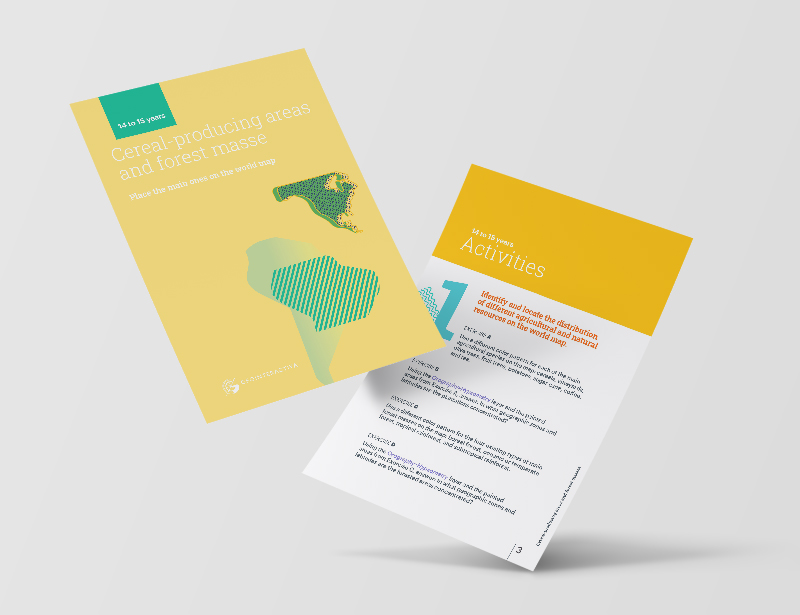
secondary (14-15 years old).
The cereal-growing areas of the world
In this activity you will discover the importance of the distribution of natural resources on the planet, especially the location of the main cereal-growing areas of the world. It is an important topic that will allow you to understand the importance of these resources for feeding the planet and for its environmental protection.
In this download you will find a pdf resource with instructions to make your classes more dynamic. On the one hand, we show you which platform tool you will be working with and, on the other hand, we propose activities suitable for students aged 14-15.
Do you want your classes to be stimulating? Start today with Geointeractiva.
we propose to teach geography in a fun way
What will your students learn from this educational activity?
Geography is a discipline that deals with the study of the earth’s surface and the interactions between human societies and their environment. One of the most important topics in geography is the distribution of natural resources on the planet. In this sense, the location and distribution of the main cereal-growing areas in the world is a relevant topic that allows us to understand the importance of these resources for the global economy, for the development of societies, for feeding the planet and for the environmental protection of the environment in which we live.
Part 1: Introduction
This article presents a possible exercise for high school students on the importance of locating the world’s main cereal zones and major forest zones. The aim of this exercise is to help students understand the geographical distribution of these natural resources and their impact on the global economy and environmental conservation.
Part 2: Identification of the world’s main cereal zones
The first step of the exercise is to identify the world’s main cereal zones. Students can use different sources of information, such as geography books, maps, specialized websites, etc. It is important for students to identify at least three cereal zones and indicate the cereal produced and the country or countries in which it is produced for each one.
For example, one possible cereal zone is the Chaco-Pampean plain in Argentina, which is one of the world’s most important wheat production zones. Another example is the Indo-Gangetic plain in India, which is the world’s main rice production zone. The European plain in France can also be mentioned, which is an important zone for wheat and barley production.
Part 3: Analysis of the importance of the world’s cereal zones
Once students have identified the world’s main cereal zones, they can be asked to analyze the importance of these zones for global food production and country development. For this, students can carry out the following activities:
Research how much of a specific cereal’s global production comes from the zone they have identified. Indicate how many countries import that cereal from the identified production zone and in what proportion. Research which countries are the main consumers of that cereal and how production in the identified zone affects the global market for that cereal. Analyze the social, economic, and environmental consequences of cereal production in the identified zone.
Part 4: Identification of major forest zones
The next step of the exercise is to identify major forest zones in the world. Students can use the same sources of information as in the case of cereal zones. It is important for students to identify at least three forest zones and indicate the type of forest and the country or countries in which it is located for each one.
For example, a possible forest zone is the Amazon rainforest in Brazil, which is the world’s largest tropical rainforest. Another example is the taiga in Russia, which is the largest extent of boreal forest in the world. The temperate forest in the United States can also be mentioned, which is an important habitat for a variety of animal and plant species.
Part 5: Analysis of the importance of the world’s forest zones
Once students have identified the major forest zones in the world, they can be asked to analyze the importance of these zones for environmental conservation and biodiversity. For this, students can carry out the following activities:
Research the total extent of the identified forest zone and its geographical distribution. Indicate how many animal and plant species are found in the identified forest zone and how many of them are endemic to the zone. Analyze the environmental indices provided by the identified forest zone, such as climate regulation, water purification, and soil erosion prevention. Research the main threats to the conservation of the identified forest zone, such as deforestation, illegal logging, and illegal mining. Reflect on the importance of the conservation of forest zones and how actions can be taken to protect and restore them.
Part 6: Conclusions
In conclusion, the identification and analysis of the world’s main cereal and forest areas is an important exercise for students to understand the geographical distribution of these natural resources and their impact on the global economy and environmental conservation. This exercise can be adapted for different educational levels and integrated into the geography curriculum of different countries.
It is important for students to understand that the distribution of natural resources on the planet is not uniform and that there are areas with greater potential for cereal production and areas with greater potential for forest conservation. Additionally, it is important for students to understand that cereal production and forest conservation are activities that must be carried out sustainably to ensure their long-term continuity.
In this sense, it is necessary for students to understand the importance of environmental conservation and biodiversity, as well as the implementation of sustainable agricultural and forestry practices. In this way, we contribute to the construction of a more just and sustainable world for all.